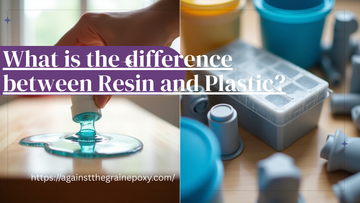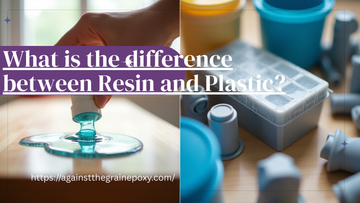What Is Resin?
Resin is a favorite material for hobbyists, especially gamers who enjoy painting or customizing models. Technically, it can be natural, like tree sap, but what most people use today is synthetic resin. The main reason it’s so popular is the detail. Resin flows into tiny corners of a mold, which means you get crisp edges and fine textures that plastic usually can’t deliver. For anyone who loves adding paint to miniatures, that level of detail makes a huge difference.
That said, resin isn’t the easiest material to handle. It’s more fragile than plastic, so parts like thin blades or armor edges can snap if you’re not careful. It also needs a bit of care when printing or finishing. Liquid, uncured resin can be toxic, so gloves, masks, and good ventilation are a must when working with it. After printing, pieces also need to be washed and cured before they’re ready.
Still, people put up with the extra steps because the results are worth it. Resin gives you smooth, high-quality surfaces and details that make painting more satisfying. If you’re chasing precision and quality over toughness, resin is almost always the better choice.
What Is Plastic?
Plastic is everywhere, from phone cases to game controllers, and it’s just as common in the hobby world. For gamers and makers, plastic is a go-to because it’s strong, easy to work with, and far less intimidating than resin. In 3D printing, common plastics include PLA, ABS, and PETG. These filaments are affordable and versatile, making them great for things like terrain, props, and gaming accessories.
Durability is where plastic really shines. It flexes under pressure, so it doesn’t snap as easily. That makes it perfect for pieces that get handled often—like dice towers or controller stands. Plastic also doesn’t require as much prep when printing, which makes it beginner-friendly.
On the production side, plastic is unbeatable for mass manufacturing. Injection molding allows companies to produce thousands of models quickly and at a lower cost. The trade-off is detail—plastic often can’t capture the same sharpness as resin, especially in smaller designs.
Overall, plastic is the steady workhorse. It’s tough, affordable, and suited for large-scale or practical builds. If resin is about fine artistry, plastic is about function and reliability. For many hobbyists, especially beginners, plastic is the obvious starting point.
Resin vs Plastic: Key Differences
Both resin and plastic are valuable in gaming projects—it just depends on what you need. Here’s how they differ in the areas that matter most.
Composition
Resin starts as a liquid and hardens when cured. Plastic is melted and shaped under heat. This makes resin perfect for sharp details, while plastic is more flexible in manufacturing.
Durability
Plastic is tougher. It bends and absorbs impact, so it’s less likely to break. Resin is rigid and looks cleaner, but thin pieces can be delicate.
Detail & Finish
This is where resin wins. It captures tiny details that give miniatures their wow factor. Plastic can still look good, but fine edges and textures often lose sharpness.
Environmental Impact
Neither option is ideal. Some resins are biodegradable, but most aren’t recyclable. PLA plastic is compostable, while ABS and PETG are petroleum-based and harder on the environment.
Cost
Plastic is affordable, both in material and production. Resin costs more, not only per print but also because of the extra curing and protective gear.
Summary
Use resin when you want showcase-level detail, but keep plastic in mind for durability, cost, and ease. Most gamers mix the two—resin for standout miniatures, plastic for everyday gear or larger builds.
Resin vs Plastic in 3D Printing
In 3D printing, the gap between resin and plastic really shows because each uses a completely different process.
Resin Printing (SLA/DLP)
Resin printers harden liquid resin one layer at a time using UV light. The results are smooth, sharp, and extremely detailed—perfect for miniatures or display models. The downside is that resin is messy and requires careful handling. You’ll need gloves, masks, and extra time for cleaning and curing.
Plastic Printing (FDM)
Plastic filament printers melt PLA or ABS and build objects layer by layer. These printers are cheaper, easier to learn, and great for bigger or functional designs like dice trays, terrain, or props. You don’t get the same fine detail, but you get stronger, more practical items.
Which to Pick?
Resin gives you details worth showing off. Plastic gives you sturdy, everyday builds with less fuss. Many gamers end up using both resin for display pieces and miniatures, and plastic for accessories and larger models.
It really comes down to what matters more for each project—detail or durability.
Resin vs Plastic in Miniatures and Models
Miniatures are a huge part of gaming, and the material you use makes all the difference.
Detail Level
Resin is known for its crisp edges and fine features. Painters love it because shading, highlights, and textures all stand out more. Plastic miniatures often blur details slightly, especially when mass-produced.
Assembly & Handling
Resin requires more care. It can be brittle and may need sanding before assembly. Thin parts are easy to snap. Plastic is easier to cut, glue, and handle without worry, which is ideal for people building large armies.
Painting
Both materials take paint well, but resin’s smoother surface usually produces a cleaner finish. Plastic often needs extra priming to hold paint evenly.
Customization
Resin is best for unique sculpts or limited editions; plastic is better for modular kits and interchangeable parts.
So what’s the better option? Resin delivers a premium painting experience and sharper looks, while plastic makes building quicker, simpler, and more forgiving. Many gamers end up choosing based on whether style or practicality matters more for their project.
Which Material Should Gamers Choose?
There isn’t a single winner between resin and plastic—it depends on what you’re making.
If your goal is a striking, detailed centerpiece miniature or collectible model, resin is the clear favorite. It comes with extra steps and higher costs, but the final result feels professional and worth the effort.
If you’re focused on durability, budget, or large builds, plastic is the smarter pick. It’s easier to work with, safer, and much more forgiving, which is why beginners prefer it.
Many gamers don’t choose one over the other—they use both. Resin is saved for the miniatures that need to look incredible, while plastic handles the tough, functional, or large-scale prints that need strength.
The real question isn’t “Which is better?” but “What do I need this for?” Understanding what each material brings to the table helps you get projects done faster, look better, and last longer.
Conclusion
Resin and plastic both bring something valuable to gaming projects. Resin delivers unbeatable detail, making it the top choice for display minis and custom pieces. Plastic offers strength, accessibility, and cost savings, which are ideal for practical or large-scale builds. In the end, the right material isn’t about which is “better” overall but about what matches your project and goals. Many gamers find success by combining the two, using resin for fine artwork and plastic for dependable utility. Choosing wisely lets you build, paint, and play with models that match your style.
Ready to bring your projects to life? Against The Grain Epoxy offers high-quality resin products that give you the smooth finish, strength, and detail your creations deserve. Whether you’re crafting miniatures or larger builds, start with materials that work as hard as you do.
FAQs (Frequently Asked Questions)
Q: Does resin break easily?
A: Yes, resin is brittle. Thin parts or sharp details can snap if handled roughly.
Q: Is plastic better for beginners?
A: Definitely. It’s affordable, easier to manage, and safer—perfect for your first projects.
Q: Can resin be recycled?
A: Most resins can’t. A few biodegradable versions exist, but they’re not widely available yet.
Q: Which material is safer?
A: Plastic. Resin requires gloves, masks, and safe disposal due to its liquid toxicity before curing.
Q: What glue should I use?
A: Super glue works best for resin. For plastic, use plastic cement, which melts and fuses the surfaces.





